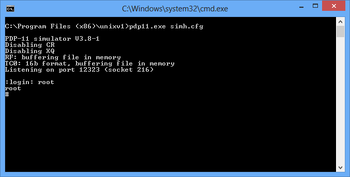UNIX First Edition
The First Edition of UNIX is, as the name suggests, the very first release of UNIX. The system was created in 1970 and originally developed for the PDP-7 (later ported to the PDP-11), and it was designed by Dennis Ritchie and Ken Thompson.
 Logging onto first edition of UNIX | |
| Developer(s) | Western Electric, AT&T |
|---|---|
| Written in | Assembly |
| family | Unix |
| Initial release | November 3, 1971 |
| Architecture | PDP-7, PDP-11 |
Restoration
The source code for UNIX First Edition was lost for many years, but in late 2008, The Unix Heritage Society managed to reconstruct the source code for the kernel as well as parts of the sources from various sources; including magnetic tapes, paper documents, etc. The writeup is available here. The source code was originally available on Google Code but is now available on GitHub.
Versions
PDP-7 version
The very first version of UNIX was made for the PDP-7, made in assembly for a spare PDP-7 at Bell Labs. At the time the OS was not called "UNIX". It was initially designed for a video game named "Space Travel" which needed graphics to display the motion of planets. Later on the system became more widely used because an OS was needed to fill the need for typesetting on minicomputers.
PDP-11 version
The system was later ported to the PDP-11, due to an increasing demand for running the OS on a machine larger than the PDP-7. Many tools were added to this version, including a text editor named roff.
Running
Docker
It's possible to run UNIX First Edition on Docker thanks to the efforts of Brian Bennett. Simply execute the following command with Docker to run it:
docker run --rm -it bahamat/unix-1st-ed
When you run the command, you'll be dropped into a PDP-11 emulator at the :login: prompt.
PDP-11 simulator V3.9-0 ./simh.cfg> #!tools/pdp11 Unknown command Disabling CR Disabling XQ RF: buffering file in memory TC: creating new file TC0: 16b format, buffering file in memory Listening on port 5555 (socket 7) :login:
Login with the root user and hit enter.
:login: root root #
You will now be logged into the system. Unfortunately, being the first version of UNIX, there isn't a lot here. Things like backspace, moving arrow keys, and stuff won't work (more on that below). Many commands we use today simply aren't there or are drastically different from what they are now... though things like ls and cat are still relatively the same!
Windows
For Windows, a special packaged version of SIMH that runs UNIX First Edition is available for download on SourceForge here.
When you start the system, you will be dropped into a :login: prompt.
PDP-11 simulator V3.8-1 Disabling CR Disabling XQ RF: buffering file in memory TC0: 16b format, buffering file in memory Listening on port 12323 (socket 216) :login:
Login with the root user and hit enter.
:login: root root #
You'll now be logged into the system. Unfortunately there isn't much to see here, being the first version of UNIX it is severely lacking in features. Many commands and features we commonly use today aren't here or are drastically different, though things like cat and ls are still relatively the same!
Quirks
Here's something interesting: the first edition of UNIX was actually not designed with monitors in mind! It used a special typewriter named a "teletype", in which you'd type commands to it, it communicated with the computer, and it would print the output to a physical piece of paper. This is why things like backspace or using the arrow keys doesn't work; it was physically impossible! This YouTube video showcases this.
Software
?